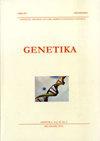Estimation of heterosis, heterobeltiosis, and gene action in F1 plants from small-seeded soybean crosses
4区 农林科学
Q3 Agricultural and Biological Sciences
引用次数: 0
Abstract
Soybeans with small seed sizes and high seed yield potential are crucial for addressing the needs of soybean-based industries. The objectives of the study were to investigate the maternal effect and quantify the value of heterosis, heterobeltiosis, and gene action in F1 plants from soybean crosses with small-seeded. In the present investigation, the experiment was conducted in the screen house of the Indonesian Legume and Tubers Crop Research Institute (ILETRI) located in Malang (East Java, Indonesia) from March to July 2021. The F1 plants were derived from crosses of Lokal Jember ? Tidar, Tidar ? Gepak Kuning, Gepak Kuning ? Detam 3, and their reciprocals. The parental genotypes and F1 plants were all planted. The observed data were plant height, number of branches, number of nodes, number of filled pods, the weight of 10 seeds, and seed yield/plant. The performance of the F1 plants showed variation for all observed traits, which is mostly averaged between the two parents, including 10 seed weight and seed yield. There was no maternal effect for almost all agronomic traits on all crosses and their reciprocals, except for the number of nodes in the cross of Gepak Kuning ? Detam 3. Heterosis (hMP) and heterobeltiosis (hHP) of F1 derived from six cross combinations for seven agronomic traits ranged from -25.93 to 186.27 and -94.83 to 114.71, respectively. Based on the potence ratio, the gene action was differed from a cross to cross for seed yield and its components. The degree of dominance for seed size and seed yield varied from overdominance, incomplete dominance, and complete dominance. Thus, based on the present investigation, it is possible to develop soybean varieties with small seed sizes and high yield by using pedigree selection on F2.大豆小粒杂交F1植株的杂种优势、杂种优势和基因作用评价
具有小粒和高产量潜力的大豆对于满足以大豆为基础的产业的需求至关重要。本研究的目的是研究大豆小粒杂交F1植株的母系效应,量化杂种优势、杂种优势和基因作用的价值。在本次调查中,试验于2021年3月至7月在位于印度尼西亚东爪哇玛琅的印度尼西亚豆科植物和块茎作物研究所(ILETRI)的筛网室进行。F1植株是由Lokal Jember ?提达,提达?葛柏古宁,葛柏古宁?Detam 3,和它们的倒数。亲本基因型和F1植株均种植。观测数据为株高、分枝数、节数、实荚数、10粒重、单株种子产量。F1植株的表现在所有观察性状上都存在差异,其中包括种子重和种子产量,这些差异在两亲本之间主要是平均的。除格柏-昆宁杂交的节数外,其余杂交及其互交的几乎所有农艺性状均不存在母性效应。Detam 3。杂种优势(hMP)和杂种优势(hHP)分别为-25.93 ~ 186.27和-94.83 ~ 114.71。根据效价比,基因在不同杂交间对种子产量及其构成因素的作用是不同的。籽粒大小和籽粒产量的显性程度有过显性、不完全显性和完全显性。因此,在本研究的基础上,利用F2进行系谱选择,培育小粒高产大豆品种是可能的。
本文章由计算机程序翻译,如有差异,请以英文原文为准。
求助全文
约1分钟内获得全文
求助全文
来源期刊

Genetika-Belgrade
AGRONOMY-GENETICS & HEREDITY
CiteScore
1.80
自引率
0.00%
发文量
1
审稿时长
6-12 weeks
期刊介绍:
The GENETIKA is dedicated to genetic studies of all organisms including genetics of microorganisms, plant genetics, animal genetics, human genetics, molecular genetics, genomics, functional genomics, plant and animal breeding, population and evolutionary genetics, mutagenesis and genotoxicology and biotechnology.
 求助内容:
求助内容: 应助结果提醒方式:
应助结果提醒方式:


